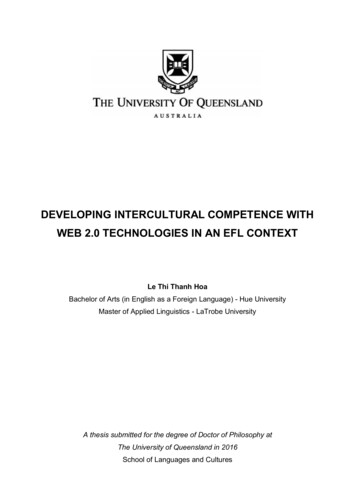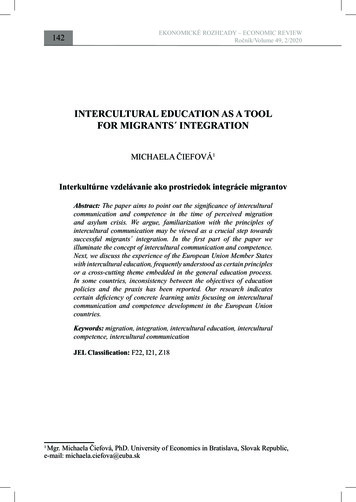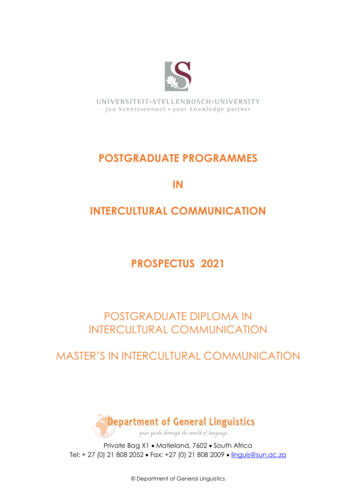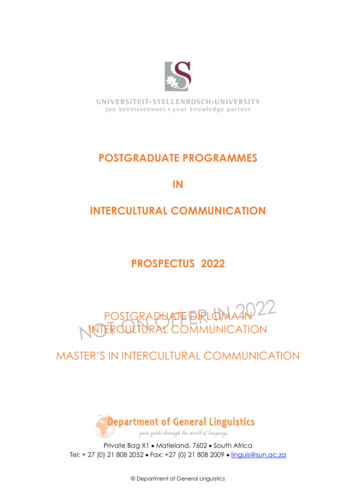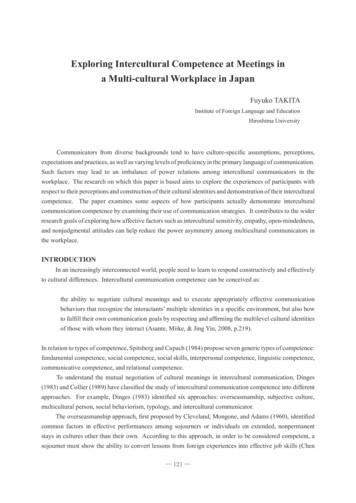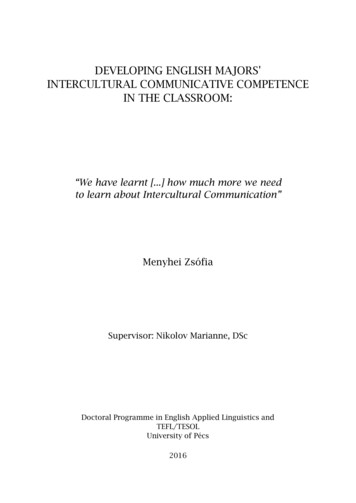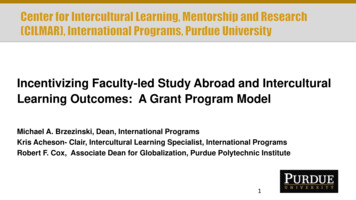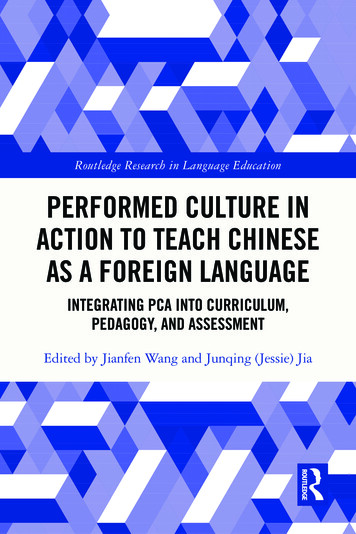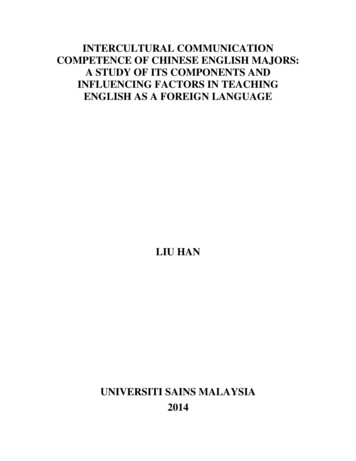
Transcription
INTERCULTURAL COMMUNICATIONCOMPETENCE OF CHINESE ENGLISH MAJORS:A STUDY OF ITS COMPONENTS ANDINFLUENCING FACTORS IN TEACHINGENGLISH AS A FOREIGN LANGUAGELIU HANUNIVERSITI SAINS MALAYSIA2014
INTERCULTURAL COMMUNICATION COMPETENCEOF CHINESE ENGLISH MAJORS: A STUDY OF ITSCOMPONENTS AND INFLUENCING FACTORS INTEACHING ENGLISH AS A FOREIGN LANGUAGEByLIU HANThesis submitted in fulfillment of the requirementsfor the degree ofDoctor of PhilosophyJanuary 2014
ACKNOWLEDGEMENTSThese acknowledgements are written to express my deepest thanks to all the peoplewho have ever helped me when I was working on this doctoral thesis. Without theirunselfish help, this dissertation could not have been completed.First, I would like to express my deepest appreciation to my supervisor, AssociateProfessor, Dr. Salasiah Che Lah. She has been with me in my whole process of PhDresearch, giving me help in life and guidance in study. She is always ready to helpme whenever I am in trouble with my research, and at the same time, encourages meto think independently. “The accomplishment of your PhD thesis is only thebeginning of your academic research”—my ears ring with her words. Moreimportantly, she sets me a good example on how to be a man as well as ascholar—modest and gentle, rigorous and precise.Second, my thanks go to the committee chairperson and examiners in my proposaldefense. Their suggestions for the improvement of the proposal prove to beinvaluable and without their help, the accomplishment of the thesis is impossible. Aspecial ‘thank you’ also goes to Professor Guo-Ming Chen, working in theHarrington School of Communication and Media, in the University of Rhode Island,the USA. His patient and timely explanations about the scales that he and his fellowscholars developed and are employed in this research are of great help in increasingii
my understandings about these instruments and their application.Third, I owe a great debt of gratitude to my friends, colleagues, and the researchparticipants. Xing Huibin and Han Hongmei are my friends as well as my colleaguesin Hebei University (HBU). They helped me a lot with either their professionalcomments and suggestions on my thesis or with their encouragement when I feltdespondent with my research. Besides, the student and teacher respondents whoparticipate in this research really helped me a lot with their time, energy, and patience.Without their cooperation, this research could not be finished.Last, but not least in importance, I am truly grateful to my family. My father andmother, advanced in age and poor in health, take all the household duties when I amfar away in Malaysia working on the PhD thesis. My wife, very busy with her owncareer, bears the burden all by herself to educate our son and to show filial respect toour parents. Without the help of my family, I would have been a fish out of water, ora tree without roots.iii
TABLE OF CONTENTSAcknowledgements . iiTable of Contents ivList of Tables. . . . .xList of Figures. . . .xiiList of Abbreviations .xiiiAbstrak xivAbstract . .xviiCHAPTER 1 – INTRODUCTION1.1 Background of the Study . . .11.1.1 IC and ICC .11.1.2 TEFL and ICC . 31.1.3 ICC Studies and TEFL in China . 51.2 Problem Statement . 101.3 Research Objectives . 121.4 Research Questions . .131.5 Scope of the Study . .141.6 Significance of the Study . 161.7 Definition of Key Terms . 191.8 Organization of the Chapters 22iv
CHAPTER 2 – LITERATURE REVIEW2.1 Introduction . . .252.2 Conceptualization and Theoretical Models of ICC . .282.2.1 Conceptualization of ICC . 282.2.2 Theoretical Models of ICC . 312.2.3 G. Chen’s Conceptualization of ICC and ICC model . . 472.2.4 Summary . . . . .502.3 Key Studies of TEFL in Developing ICC . . .532.3.1 Teaching Materials, Methods and Models . .532.3.2 Teachers Prepared for Culture and Language Education 622.3.3 Internet in Developing ICC .682.3.4 Teaching-and-learning Language-and-culture. . 732.4 Assessment of ICC .782.4.1 Indirect Assessment Tools . . .792.4.2 G. Chen and his Fellow Scholars’ ICC Assessment Tools . 812.4.3 Direct and Blended Assessment Tools 852.4.4 Assessing ICC in Education .872.5 Review of Key Studies in China . .922.5.1 Theoretical Inquiry in ICC .932.5.2 Culture Learning and Language Learning in Practice .1002.6 A Conceptual Framework for this Research . . 115v
2.7 Summary . .117CHAPTER 3 – METHODOLOGY3.1 Mixed Methods for this Research . . .1203.2 Methods for the Questionnaires . . .1243.2.1 Sample . . .1243.2.2 Procedure . .1263.2.3 Measurement 1283.2.4 Data analysis. . . .1313.3 Methods for the Interviews . . . .1343.3.1 Sample .1343.3.2 Procedure . . .1363.3.3 Measurement .1383.3.4 Data analysis .1393.4 Pilot Study . . 1423.4.1 Pilot Questionnaires . .1423.4.2 Pilot Interviews .1513.5 Ethical Issues in this Research . . 153CHAPTER 4 – RESULTS AND FINDINGS4.1 Results from the Questionnaires .1554.1.1 Preliminary Analyses of the Questionnaires . . 156vi
4.1.2 Main Analyses of the Questionnaires . 1684.2 Results from the Interviews 1824.2.1 The Interpretation of Theme One—Setting . . 1834.2.2 The Interpretation of Theme Two—Learner 1874.2.3 The Interpretation of Theme Three—Teacher . 1904.2.4 The Interpretation of Theme Four—Curriculum 1934.2.5 The Interpretation of Theme Five—Assessment . 1964.3 Triangulation of the Quantitative and Qualitative Results. . . 2004.4 Summary of the Findings 2054.4.1 Findings about the First Research Question 2054.4.2 Findings about the Second Research Question 2054.4.3 Findings about the Third Research Question . 2074.4.4 Findings about the Fourth Research Question 207CHAPTER 5 – DISCUSSION AND CONCLUSION5.1 Discussion of the Findings . 2095.1.1 Discussion of the Findings Related to Research Question One . 2105.1.2 Discussion of the Findings Related to Research Question Two . 2135.1.3 Discussion of the Findings Related to Research Question Three. 2165.1.4 Discussion of the Findings Related to Research Question Four . 2195.2 Implications of the Study . . 2245.2.1 Theoretical Implications of the Study . .224vii
5.2.2 Empirical Implications of the Study . .2255.2.3 Methodological Implications of the Study. 2275.3 Limitations of the Study . 2295.4 Suggestions for Future Research 2335.5 Conclusion . 235References . . 237AppendicesAppendix A: Intercultural Awareness Instrument 262Appendix B: Intercultural Sensitivity Scale . 264Appendix C: Intercultural Effectiveness Scale 267Appendix D: Scale of Influencing Factors of ICC in TEFL 270Appendix E: Intercultural Awareness Instrument (revised version) 274Appendix F: Intercultural Sensitivity Scale (revised version) 276Appendix G: Intercultural Effectiveness Scale (revised version) 279Appendix H: Scale of Influencing Factors of ICC in TEFL (revised version). 282Appendix I: Information Sheet for the Survey 285Appendix J: Information Sheet for the Interview 287Appendix K: Interview Guide . 289Appendix L: A Letter of Consent for the Interview .293Appendix M: Conceptual Schemas of the Five Themes of the Interview 295viii
Appendix N: The Pilot Version of Interview Questions 303Appendix O: The Factor Scree Plot of the ISS 305Appendix P: The Factor Scree Plot of the IES 306Appendix Q: The Scatterplots for the Relationships between the IAI, ISS,and IES . .307Appendix R: The Factor Scree Plot of the SIFIT . 309Appendix S: List of Publications . 310ix
LIST OF TABLESPageTable 2.1Alternative Terms for ICC29Table 2.2Items best Acknowledged by Scholars as ICC Components30Table 2.3Byram’s Theoretical Model of ICC34Table 2.4Teacher’s Conceptions of the Intercultural Dimensions in TEFL67Table 2.5The Most Prominent Indirect Assessment Tools of ICC80Table 2.6An Overview of the Direct and Blended Assessment Tools86Table 3.1The Summary of the Reliability Analysis of the IAI146Table 3.2The Summary of the Reliability Analysis of the ISS147Table 3.3The Summary of the Reliability Analysis of the IES148Table 3.4The Summary of the Reliability Analysis of the SIFIT148Table 3.5The Model Fit Summary of the Confirmatory Factor Analysisof the ISSTable 3.6149The Model Fit Summary of the Confirmatory Factor Analysisof the IES150Table 4.1The Summary of the Reliabilities of the IAI, ISS, IES, and SIFIT157Table 4.2The KMO and Bartlett’s Test Results of the ISS and IES159Table 4.3The Factor Eigenvalue, Variance, and Cumulative Varianceof the ISS160Table 4.4The Factor Items, Loadings, and Communalities of the ISS161Table 4.5The Factor Eigenvalue, Variance, and Cumulative Variancex
of the IES163Table 4.6The Factor Items, Loadings, and Communalities of the IES163Table 4.7Descriptive Statistics of the IAI, ISS, and IES165Table 4.8Descriptive Statistics of the Factors in the ISS166Table 4.9Descriptive Statistics of the Factors in the IES167Table 4.10Pearson Correlations between the three Dimensions of ICC170Table 4.11The Correlations between the Factors in the ISS172Table 4.12The Correlations between the Factors in the IES173Table 4.13 The KMO and Bartlett’s Test Results of the SIFIT175Table 4.14 The Factor Eigenvalue, Variance, and Cumulative Varianceof the SIFIT176Table 4.15 The Factor Items, Loadings, and Communalities of the SIFIT176Table 4.16179Descriptive Statistics of the SIFIT and its FactorsTable 4.17 Descriptive Statistics of the Items in the Second FactorTable 4.18of the SIFIT179The Correlations between the Factors in the SIFIT and ICC180Table 4.19 A Summary of the Results Answering the Fourth ResearchQuestion201xi
LIST OF FIGURESPageFigure 1.1Concentric Circles of English7Figure 2.1The Developmental Model of Intercultural Sensitivity33Figure 2.2Fantini’s ICC Model38Figure 2.3Pyramid Model of Intercultural Competence41Figure 2.4Process Model of Intercultural Competence42Figure 2.5Lussier’s ICC Model44Figure 2.6G. Chen’s ICC Model49Figure 2.7ICC Assessment Methods Used by Higher Education Institutions89Figure 2.8The Tight Coupling Model of Language Teaching and CultureTeaching111Figure 2.9ICC Framework in Foreign Language Teaching114Figure 2.10A Conceptual Framework of Developing ICC in TEFL115Figure 3.1A Road Map of the Mixed-method Research Design122xii
LIST OF ABBREVIATIONSCCWEP: Cross-cultural Writing Exchange ProgramCJFD: Chinese Journal Full-text DatabaseCNKI: China National Knowledge InfrastructureCSSCI: Chinese Social Science Citation IndexDMIS: Developmental Model of Intercultural SensitivityHBU: Hebei UniversityIAI: Intercultural Awareness InstrumentIC: Intercultural CommunicationICC: Intercultural Communicative Competence / Intercultural CommunicationCompetence / Intercultural CompetenceIDI: Intercultural Development InventoryIES: Intercultural Effectiveness ScaleISS: Intercultural Sensitivity ScaleSIFIT: Scale of Influencing Factors of ICC in TEFLTEFL: Teaching English as a Foreign LanguageTESL: Teaching English as a Second LanguageTESOL: Teaching English to Speakers of Other LanguagesUSM: Universiti Sains Malaysiaxiii
KOMPETENS KOMUNIKASI ANTARABUDAYAPELAJAR CHINA BERPENGKHUSUSAN BAHASAINGGERIS: SATU KAJIAN TENTANG KOMPONENDAN FAKTOR-FAKTOR YANG MEMPENGARUHINYADALAM PENGAJARAN BAHASA INGGERIS SEBAGAIBAHASA ASINGABSTRAKPerkembangan pengantarabangsaan dan globalisasi yang pesat menjadikan jarakseantero dunia semakin kecil dan hal inilah yang telah mendesak kewujudankeperluan komunikasi merentasi budaya. Kajian ini bertujuan untuk menyelidikkompetens komunikasi antarabudaya (ICC) pelajar Cina yang berpengkhususanbahasa Inggeris dengan berbekalkan dua set soalan kajian: Salah satunyamempersoalkan tentang perkaitan hubungan antara tiga dimensi ICC pelajar Cinayang berpengkhususan bahasa Inggeris dengan antara faktor dalam dimensi sikapdan tingkah laku yang memperihalkan kompetens komunikasi antarabudaya pelajarCina yang berpengkhususan bahasa Inggeris. Set soalan kedua pula mengenai faktoryang mempengaruhi perkembangan kompetens komunikasi antarabudaya pelajarCina yang berpengkhususan bahasa Inggeris dalam pengajaran bahasa Inggerissebagai bahasa asing (TEFL) dan tahap pengaruh faktor ini terhadap perkembangankompetens komunikasi antarabudaya mereka. Bagi merungkai persoalan kajian ini,xiv
kaedah penyelidikan kuantitatif dan kualitatif dijalankan berdasarkan modelkompetens komunikasi antarabudaya Professor G. Chen. Berdasarkan modelkompetens komunikasi antarabudaya tiga skala yang dikembangkan oleh Profesor G.Chen dan rakan sarjana yang lain, prestasi pelajar akan dinilai dalam konteks tigadimensi ICC. Skala yang dikembangkan oleh para penyelidikberdasarkanpemboleh ubah kontekstual dalam pembelajaran budaya yang juga diutarakan olehProfesor Paige dan sarjana yang lain digunakan untuk mengkaji faktor dalam TEFLyang mungkin mempengaruhi prestasi kompetens komunikasi antarabudaya pelajar.Terdapat 195 pelajar yang berpengkhususan bahasa Inggeris di Universiti Hebei(HBU) mengambil bahagian dalam kajian ini dengan menjawab empat soal selidikyang dinyatakan di atas. Selain daripada soal selidik tersebut, lapan pelajarberpengkhususan bahasa Inggeris dan dua pensyarah bahasa Inggeris di HBU jugaditemubual secara menyeluruh dalam untuk mengkaji tentang faktor dalam inayangberpengkhususan bahasa Inggeris. Kajian ini menghasilkan penemuan yang baru, adayang telah disahkan oleh para pengkaji sebelumnya manakala terdapat jugapenemuan yang tidak konsisten dengan dapatan literatur sebelumnya. Sebagai contoh,dimensi kognitif ICC mungkin mempunyai kaitan dan juga mungkin tidakmempunyai kaitan langsung dengan dua lagi dimensi ICC iaitu dimensi sikap dantingkah laku walaupun dimensi sikap dan tingkah laku berkait rapat antara satu samalain. Penemuan lain pula menunjukkan kebanyakan responden belajaranbudaya.Walau
bagaimanapun, terdapat penilaian berbeza oleh responden mengenai fungsi faktormultimedia dan internet sebagai langkah pembelajaran budaya. Salah satu penemuanyang menarik memperihalkan tentang hubungan antara faktor dalam TEFL danprestasi kompetens komunikasi antarabudaya pelajar. Hasil dapatan menunjukkanbahawa kedua-dua pemboleh ubah ini tidak berkait rapat antara satu sama lain yangjuga membawa maksud bahawa terdapat faktor lain yang lebih mempengaruhipelajar Cina yang berpengkhususan dalam bahasa Inggeris berbanding faktor dalamTEFL. Walaupun kajian ini membuahkan hasil dan memberikan impak yangsepatutnya, namun kajian ini terhad disebabkan faktor seperti penilaian, populasikajian dan kaedah penyelidikan. Oleh itu, lebih banyak kajian sepatutnya dilakukanpada masa hadapan agar domain ini dapat dikaji dengan lebih mendalam dan teliti.xvi
INTERCULTURAL COMMUNICATION COMPETENCEOF CHINESE ENGLISH MAJORS: A STUDY OF ITSCOMPONENTS AND INFLUENCING FACTORS INTEACHING ENGLISH AS A FOREIGN LANGUAGEABSTRACTWith the rapid development of internationalization and globalization, this world isbecoming smaller and smaller, and the necessity to communicate with people fromother cultures successfully is becoming increasingly urgent. This research is designedto investigate Chinese English majors’ intercultural communication competence(ICC), and this target is split into following two sets of research questions: first, whatare the relationships between the three dimensions of Chinese English majors’ ICCand those between factors in the attitudinal and behavioral dimensions of ChineseEnglish majors’ ICC? Second, what are the factors in teaching English as a foreignlanguage (TEFL) that may influence Chinese English majors’ ICC development andto what extent do these factors influence their ICC development? To answer theseresearch questions, both quantitative and qualitative research methods are employed.Three scales that are developed by Professor G. Chen and his fellow scholars on thebasis of G. Chen’s ICC model are used to assess students’ performance in the threedimensions of ICC. One scale that is developed by this researcher on the basis of thecontextual variables in culture learning that are suggested by Professor Paige and hisxvii
fellow scholars is used to investigate the factors in TEFL that may influence students’ICC performance. There are altogether 195 English majors in Hebei University(HBU) that participate in this research by answering these four questionnaires.Besides the questionnaires, semi-structured and in-depth interviews are alsoconducted to investigate the factors in TEFL that may influence Chinese Englishmajors’ ICC development; and a total number of eight English majors and twoEnglish teachers in HBU participate in these interviews as respondents. This researchyields fruitful findings—some of them are new, some of them are confirmed byprevious researches, and some of them are inconsistent with previous literature. Forexample, the cognitive dimension of ICC is either loosely or not at all correlated withthe other two dimensions of ICC, namely, attitudinal and behavioral dimensions;while these two attitudinal and behavioral dimensions are closely correlated witheach other. Another finding shows that most of the respondents think theenvironment for their culture learning is unfavorable; but as for the functions of thefactor of multimedia and internet measures in culture learning, there aredifferentiated evaluations coming from the respondents. One more interesting findingis about the relationships between the factors in TEFL and students’ ICCperformance. The result shows that these two variables are not strongly correlatedwith each other, which means that there must be some other factors that bring moreinfluence upon Chinese English majors’ ICC performance than the factors in TEFLdo. Fruitful and implicative the research is, it is limited by factors like measurement,research population, and research methods; and it is suggested that in the future,xviii
more researches should be done to go further and deeper along this direction.xix
CHAPTER 1 INTRODUCTION1.1 Background of the StudyIt is necessary to introduce the most important background information about thisresearch at the very beginning of the thesis. In this section, following topics arecovered: first, what are intercultural communication (IC) and interculturalcommunication competence (ICC)? Second, what is the relationship between theteaching English as a foreign language (TEFL) and ICC? Third, what is the currentsituation of ICC studies and TEFL in China?1.1.1 IC and ICCAs the development of internationalization and globalization, people of differentcultural backgrounds are now living in this world of global village, and one of themost frequently asked questions is “how could people communicate successfullywhen they do not share the same or similar cultural origins?”IC “occurs when a member of one culture produces a message for consumption by amember of another culture. (it) is communication between people whose culturalperceptions and symbol systems are distinct enough to alter the communication1
event” (Samovar & Porter, 2000, p. 48). Following subjects are the most oftenexamined ones in IC studies: conceptualization of culture, communication, andintercultural communication; perception (cultural values, world views, socialorganizations); communicative competence (verbal and nonverbal processes); andintercultural application (intercultural adaptation, intercultural training, and ICC)(Fantini, 1997; Samovar & Porter, 2003).ICC refers to “the ability to communicate effectively and appropriately inintercultural situations based on one’s intercultural knowledge, skills, and attitudes”(Deardorff, 2004, p. 194). It is one of the important research fields in IC studies. ICCstudies are highly interdisciplinary in nature—linguistics, education, communication,cultural anthropology, psychology and sociology, all contribute to its development.Existing literature shows that ICC is basically composed of three major components:knowledge, attitudes, and skills—representing the cognitive, attitudinal/affective, andbehavioral dimensions of ICC, respectively (Byram, 1997; G. Chen & Starosta,1998; Fantini, 2000a; Lussier, 2009b).Various theoretical models have been developed to define and describe ICC in thepast years. G. Chen’s model (G. Chen, 2009a) is one of the most influential andwell-accepted ones, in which there are three major dimensions of ICC—interculturalawareness, intercultural sensitivity, and intercultural effectiveness. And from each ofthese dimensions (except for intercultural awareness), a few factors are extracted2
based on their theoretical conceptualization of the ICC components and the scalescomposed accordingly (G. Chen & Starosta, 2000; Portalla & Chen, 2009). In thisstudy, the relationships between the ICC dimensions and those between the factors inthe attitudinal and behavioral dimensions of ICC are examined on the basis of G.Chen’s theoretical model.1.1.2 TEFL and ICCTo be a ‘fluent fool’, as Bennett (1997) puts it, is more dangerous than to be the oneswho could not speak English fluently while better understand the social and culturalindicators of IC, because the more fluent he/she is in speaking a certain foreignlanguage the more likely he himself as well as others will overestimate his ability tohandle an intercultural situation, while in fact, he/she could be rather ignorant of thevalues, beliefs and customs of the person who speaks this language, and thus bringsfailure or even disaster to the actual communication.So language and culture are interrelated. Language acquisition and culture learningare interrelated. TEFL and the development of ICC are interrelated. In order to makeit clear the relationship between TEFL and ICC, first, let us take a brief look at thedevelopmental history of the aim of TEFL.The aim of TEFL has changed over the years. First, it is linguistic competence3
(Chomsky, 1965), stressing the correct mastery of a foreign language. Then it iscommunicative competence (Hymes, 1972), stressing some sociolinguistic skills andthe appropriate expression in communication. TEFL, under the guidance ofcommunicative competence theory, takes the native speaker as the model (Byram,1997; Cook, 1999). Now, however, as the development of internationalization andglobalization, English is becoming a lingua franca and different Englishes are beingused all around the world. As a result, English has become a bridge between differentcultures—a bridge between native speakers and native speakers, native speakers andnon-native speakers, non-native speakers and non-native speakers. Therefore, anEnglish language learner is now expected to become a mediator or ‘interculturalspeaker’ between different cultures. An ‘intercultural speaker’ is someone who“mediates between two or more cultural identifications. S/he is someone who crossesfrontiers and to some extent is a specialist in the transit of cultural property andsymbolic values” (Byram & Zarate, 1997, p. 11). As a result, the ultimate purpose ofTEFL has changed from communicative competence to ICC, since ‘accommodation,reflection and mediation skills’ are objectives both in English as internationallanguage status and in theoretical models of ICC (Byram, 1997; Byram & Fleming,1998; Byram, Nichols, & Stevens, 2001; G. Chen & Starosta, 1998; Mete, 2009; H.Zhang, 2007).There are three components of knowledge, attitudes and in skills ICC, as has beenmentioned above, and this is also a well-established classification in light of the4
classical taxonomy of educational objectives developed by Bloom and his colleagues(Bloom, 1956; Krathwohl, Bloom, & Masia, 1964). So it is crucial for us toinvestigate the factors in TEFL that may bring significant influence upon students’ICC, if we want to develop students’ ICC in English language learning programs.1.1.3 ICC Studies and TEFL in ChinaICC could be compared to the fruit in the tree of IC. It is one of the most importantand popular research fields in IC as well as teaching English to speakers of otherlanguages (TESOL). But in China, ICC studies, as well as IC studies, have been in amarginalized position and ICC researchers are predominantly foreign languageteachers in colleges and universities, even though ICC is so interdisciplinary a fieldof research. According to Peng (2010), IC has not become a mainstream academicresearch field in China. Only 13.5% of all the published papers concerning IC during2000 and 2010 are included in Chinese Social Science Citation Index (CSSCI), withthe rest of the papers published in those unknown or non-academic journals. Anotherproblem with IC studies in China is that empirical study is very rare. According to W.Hu (2006a), of all the IC research papers included in Chinese Journal Full-textDatabase (CJFD), only 5.6‰ could be identified as papers of empirical study. As forICC studies, this researcher has not even found any review articles discussing itssituation in China.5
Next, let us take a look at the overall situation of TEFL in China. English is taught asa foreign language in China—the so called TEFL. English is neither native language(as in the United Kingdom and the United States of America) nor second language(as in Malaysia and India). It is taught for the purposes of traveling in foreigncountries, doing business with foreigners, translating literary, science and technologyworks into Chinese or vice versa and conducting all kinds of international anddiplomatic activities. It is not a working language employed in workplaces except inSino-foreign joint ventures or wholly foreign-owned companies. In daily life, onecould live comfortably without being able to read, write or speak English. On thewhole, one could survive without English in China. While in countries where Englishis taught as a second language (the so-called TESL—teaching English as a secondlanguage), as in India and Malaysia, the situation is quite different. Besides theaforementioned purposes for TEFL countries, people in these TESL countries learnEnglish mostly for the convenience, even the survival in their daily lives. In thesecountries, English is widely used in government, in business, in media as well as inschools of different stages.Kachru’s (1992) concentric circles of English could best illustrate China’s status inEnglish-speaking communities comparing with other countries (see Figure 1.1).There are three concentric circles—the inner circle, the outer circle, and theexpanding circle. These circles of English are drawn for us to better understand theuse of the language in different countries. In the inner circle countries, such as the6
USA, the UK, and Australia, English is spoken as their native tongue; in the outercircle countries, such as India, Malaysia, and Nigeria, English is spoken as eithertheir second language or official language due to historical reasons; and in theexpanding circle countries, such as China, Egypt, and Russia, English is treated as aforeign language.Expanding Circle(e.g., China, Egypt,Russia)Outer Circle(e.g., India, Malaysia,Nigeria)Inner Circle(e.g., the USA, the UK,Australia)Figure 1.1 Concentric Circles of English(Source: Kachru, 1992)In English language learning classrooms of China, TEFL is still dominantly teachercentered, textbook-based and exam-oriented. In primary schools, where Englishteaching begins from Grade 3 and lasts for four years, there are not enough qualifiedEnglish teachers at all—only a small number of them graduate from colleges oruniversities majoring in English. In middle schools (six grades altogether), including7
both junior and senior middle schools, teachers are busy with basic languageproficiency teaching and assessment—their main focus of English teaching isgrammar and vocabulary with the main purpose of pushing the students pass theexams of various kinds and levels.However, the situation in colleges is a little bit different from that in primary andmiddle schools. First, most of the teachers are postgraduates majoring in Englishwith either Master’s or Doctor’s degree. Therefore, they are supposed to be qualifiedEnglish teachers both linguistically and interculturally. Second, students are nolonger pressured so much by exams as they are in primary and middle schools, eventhough exams still remain. In fact, they feel much freer to do what they are interestedin and what seems to be important to them in language learning. This is even morethe case for English majors in colleges and universities, and this situation partiallyaccounts for the choosing of English majors a
INTERCULTURAL COMMUNICATION COMPETENCE OF CHINESE ENGLISH MAJORS: A STUDY OF ITS COMPONENTS AND INFLUENCING FACTORS IN TEACHING ENGLISH AS A FOREIGN LANGUAGE By . "The accomplishment of your PhD thesis is only the beginning of your academic research"—my ears ring with her words. More
